Terror of Mechagodzilla ~ 1975, Ishiro Honda – Japan
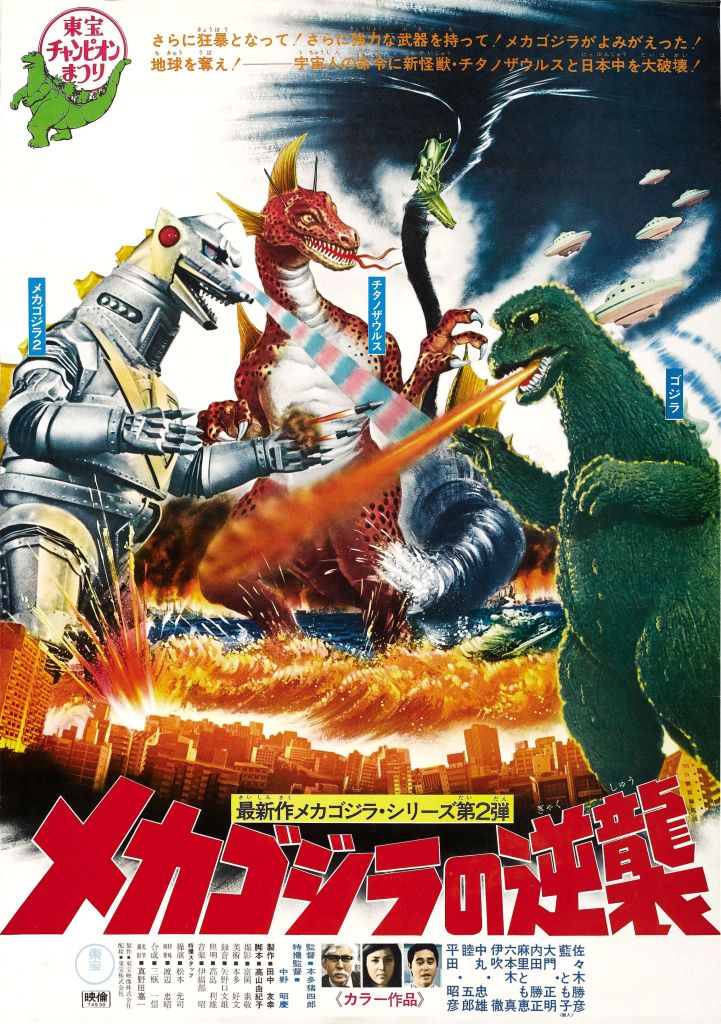
After twenty-one years and fifteen movies, the original Godzilla franchise comes to an end with the solid, yet sadly anti-climactic Terror of Mechagodzilla. This is also the first Godzilla film Ishiro Honda has directed since 1969’s Godzilla’s Revenge, and it’s good to see him back for the finale. Honda pulls out all the stops this time around, embracing more dynamic quick cuts and dramatic camera angles, as well as some hip 70’s split screen techniques, all more typical of fellow Godzilla director Jun Fukuda’s work than of his own. It’s almost like he wanted one more opportunity to prove that he could beat these youngsters at their own game, and it does certainly level the playing field a bit. While Honda’s work is invaluable to the kaiju lexicon, his composition was always governed by more classic sensibilities. With Terror of Mechagodzilla we’ve got that masterful Honda style, but with a little of Fukuda’s zazz thrown in. That’s a strong mix, yo.
The downside: It’s damn aliens again.

THE PLOT~ After the destruction of Godzilla’s robot doppelgänger in Godzilla Vs Mechagodzilla, Japanese scientists travel to the supposed undersea wreckage site, in hopes of retrieving the pieces of said robot so that they can use them to do terrible, terrible things (I’m sure), but to their surprise, they instead find Titanosaurus, a huge, aquatic dinosaur, right where Mechagodzilla should be. Oh hell! Titanosaurus’ existence was theorized years ago by a prominent scientist named Dr. Shinji Mafune (played by franchise favorite Akihiko Hirata!), to which the scientific community responded “A dinosaur?! What are you, crazy? Get this guy out of here!” I don’t really understand anyone’s reaction to Titanosaurus in this movie, even the present day scientists act like the discovery of a living dinosaur is a huge deal, when Japan is decimated by warring dinosaurs like, twice a week at this point. Remember, guys? You see dinosaurs every day? You all probably know someone who has been killed by a dinosaur at this point? Why is one more dinosaur so damn mind blowing? Whatever, you guys. Anyway. We Earthlings would soon regret our treatment of Mafune, because after years in isolation and disgrace, this hombre has gone coo coo for cocoa puffs, big time. It’s so bad that he’s actually betrayed mankind and formed a partnership with dastardly space aliens, here to conquer the Earth and wipe out human civilization, so we really should have been nicer to him about his freaking dinosaur.
These aliens need Mafune, because his intellect is so substantial that even a race of beings who have mastered space travel think he’s pretty damn smart. Logically, however, they have to know that they can trust him, so as a means of further guaranteeing Mafune’s loyalty to their evil cause, these aliens use their far-out space-technology to revive his daughter Katsura after she is killed in a lab accident. Granted, she’s a damn cyborg now, but Mafune is good with this. He and the aliens then hatch a two-fold invasion plan; one; Mafune’s state of the art “animal controlling device” is rigged up and used to manipulate Titanosaurus into smashin’ shit and killin’ folks. Two; using technology based on Mafune’s designs, Mechagodzilla is repaired and deployed for a similar purpose. Without Mafune’s knowledge, however, the aliens bind Mafine’s robo-daughter to Mechagodzilla, meaning that if one of them dies, so does the other, just in case the good doctor should decide to flip flop back over to Team Earthling. Looks like Mafune’s really in it for the long haul now.

Meanwhile, Interpol, aided by a marine biologist called Akira Ichinose, have been sniffin’ around Titanosaurus, as well as the missing Mechagodzilla pieces, and soon the two sides meet in a dance of espionage, gunfire, and shiny, spaceman costumes with stupid helmets. Ichinose develops romantic feelings for Katsura Mafune, unaware that she is 1; In league with would be Earth conquerors from space and 2; A damn cyborg. My favorite line in the movie comes toward the end, when Ichinose discovers the truth about Katusra, and tells her “Even if you are a cyborg, I love you.” We shouldn’t be surprised, this is a culture where grown men have developed committed, romantic relationships with body pillows. A cyborg is like a body pillow in many ways.
Also, Godzilla eventually shows up. He’s not in this thing enough. That’s a major beef for me.
It’s all a mixed bag, as always. While it’s impossible to ignore the significant updates Honda has made to his screen language repertoire, he doesn’t ever employ the use of these more jazzy techniques to the degree that Fukuda does, and they actually stand out more because they’re so isolated to key sequences, like when Titanosarus rises up out of the sea. Fukuda had also pushed the envelope in how violent the monster battles were allowed to get, which included the use blood effects, and that really heightened the drama, Those effect shots are largely absent from this entry (although Mecha-G’s revolving finger-rocket punches a hole in Godzilla’s chest at one point, and that’s pretty heavy). While I don’t want to say that blood is mandatory for Godzilla movies now or ever, it did help add a sense of desperation and risk to the conflicts when it was used well in the past, and it’s hard to step backwards from that without losing some of the momentum the audience has now come to expect.
One thing that Honda does do that surprised me more than a bit; Damn android nipples! While Katsura is being fiddled with and modified by our aliens, we get a weird, uncomfortable gander at her bare chest. Now, see here, Toho, we Westerners have demonized the hell out of that whole region of the female anatomy for centuries, so toss a blanket over her or something. Get back to widespread destruction and the death of human beings, what a woman has under her clothes is a most dark and sinful thing, and we want no part of your freaking space martian peep-show.
Also problematic; the aliens themselves. They don’t even appear to be the same aliens from the prior film, which would really have helped sugarcoat the situation. These aliens come from “Black hole third planet,” and are profoundly uninteresting. Past Godzilla films have done a much better job making their aliens distinct, as well as elevating the Earth Vs Aliens conflict to make it feel more global, and more dramatic. The best example of this was probably Destroy All Monsters, but the aliens in Terror of Mechagodzilla are maybe my least favorite of all the Showa E.T. Interlopers. Truly, they are nothing special, and when you do something over and over and over again for years and years, dammit, you need to make it special somehow.
A highlight I wanted to mention; Akihiko Hirata’s performance as Dr. Mafune. Firstly, he’s been with the franchise from the beginning, so it’s cool having him back in a prominent role as this series comes to a close. He also does a good job in this role even without acknowledging his position as an original cast member, and he’s likely to stand out as especially memorable even if this is the first Godzilla film you watch. He looks like a Japanese Einstein, and his portrayal of a brilliant mind driven to madness is enjoyably manic. While most of the cast is likable, he stands above the rest in Terror of Mechagodzilla as being a real asset.
Beyond it’s glaringly scant Godzilla and monster screen time, the film is pretty solid, but not perfect. Even excluding Gojira, Honda has shot much, much better Godzilla films before this one, And Terror Of Mechagodzilla doesn’t feel like a big enough deal. Past entries in the Showa cannon were made with the understanding that they would be the final Godzilla film, so they managed to go out with a bang in a way that Terror of Mechagodzilla doesn’t. It’s no kind of finale, and it doesn’t even feel deliberately open-ended, the film just ends, as its predecessors had done, and that was that. Given that this was the last time audiences would see Big G for a while, it would have been nice to enjoy a better send off, but I suppose we aren’t often given that luxury in life.
I’m getting all philosophic here!
B


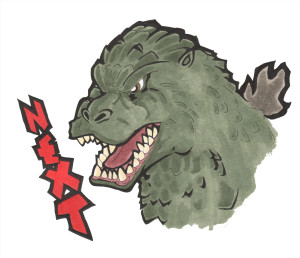
 Even the poster is lame.
Even the poster is lame. THAT’S a poster.
THAT’S a poster.
 GODZILLA- Just a big ol’ softy. In this one, Godzilla’s head has been redesigned,
GODZILLA- Just a big ol’ softy. In this one, Godzilla’s head has been redesigned, 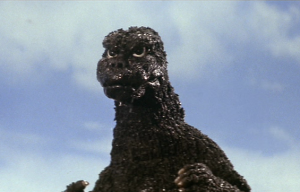 his eyes are much larger, and more frontal, which gives him a more humanoid and friendly appearance. Godzilla also observes different human customs, such as the shaking of hands, and feeling insulted when Megalon taunts him with his weird monster butt-slap dance. Things were getting a little Gamera by this point.
his eyes are much larger, and more frontal, which gives him a more humanoid and friendly appearance. Godzilla also observes different human customs, such as the shaking of hands, and feeling insulted when Megalon taunts him with his weird monster butt-slap dance. Things were getting a little Gamera by this point.


 Once a towering, insurmountable force for death and destruction destined to blanket the Earth in grim darkness, fire and blood, Godzilla is now totally cool and nice, you guys. Not only is he no longer a bad guy, but in Godzilla VS Gigan, he’s a damn underdog. Most Godzilla films portray him as an unstoppable, scaly juggernaut, the unbeatable conclusion to any conflict, but in GVG it kinda seems like his monstrous snout has finally bit off more than it can chew. He really takes a lot of abuse this time around, including, at one point, a full on Ghidoriah lightning bolt attack to his dragon balls. Rough. (NOTE: Apparently, this shot is actually recycled footage from Ghidorah: The Three Headed Monster. So, apparently this has happened to Godzilla twice now!)
Once a towering, insurmountable force for death and destruction destined to blanket the Earth in grim darkness, fire and blood, Godzilla is now totally cool and nice, you guys. Not only is he no longer a bad guy, but in Godzilla VS Gigan, he’s a damn underdog. Most Godzilla films portray him as an unstoppable, scaly juggernaut, the unbeatable conclusion to any conflict, but in GVG it kinda seems like his monstrous snout has finally bit off more than it can chew. He really takes a lot of abuse this time around, including, at one point, a full on Ghidoriah lightning bolt attack to his dragon balls. Rough. (NOTE: Apparently, this shot is actually recycled footage from Ghidorah: The Three Headed Monster. So, apparently this has happened to Godzilla twice now!)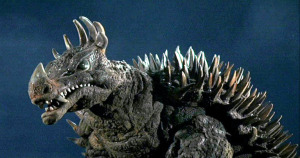 Anguirus has also come a long way from being Godzilla’s most hated rival to the sturdy, dependable, four legged BFF we see in GVG. Now he’s like, the “solid dude” of the kaiju kingdom, Anguirus is the monster who would come over to help you move. I mean, he’s a quadruped, with no apparent dragon breath or laser eyes, so his offensive capabilities are pretty much limited to biting and just being spiky, but he’s still out there in the fray, taking his lumps and doing what he can to back up his bros. If Godzilla seems like the underdog in this battle, Anguirus is straight outclassed, and you might find yourself worried about the little guy. I know I was!
Anguirus has also come a long way from being Godzilla’s most hated rival to the sturdy, dependable, four legged BFF we see in GVG. Now he’s like, the “solid dude” of the kaiju kingdom, Anguirus is the monster who would come over to help you move. I mean, he’s a quadruped, with no apparent dragon breath or laser eyes, so his offensive capabilities are pretty much limited to biting and just being spiky, but he’s still out there in the fray, taking his lumps and doing what he can to back up his bros. If Godzilla seems like the underdog in this battle, Anguirus is straight outclassed, and you might find yourself worried about the little guy. I know I was! What is Ghidorah the king of, anyway? Pissing me off, that’s what. Anytime aliens pop in, they summon Ghidorah from the cold recesses of space to shriek, fly around, wiggle his three heads and barf lightning at everybody. GVG is no different, which proves just how successful his outer-space Craig’s List ads are.
What is Ghidorah the king of, anyway? Pissing me off, that’s what. Anytime aliens pop in, they summon Ghidorah from the cold recesses of space to shriek, fly around, wiggle his three heads and barf lightning at everybody. GVG is no different, which proves just how successful his outer-space Craig’s List ads are. This guy is the big addition to GVG. Gigan is basically like, the Boba Fett of the Kaiju world. He’s a cypher, he has no purpose and no drive of his own, he’s here to do his job; kill monsters and bust shit up. He’s like a giant monster hit man, hired on by aliens to dish out the death, because truly, that is what he was made to do. This damn thing has no hope of ever living a normal life, and that is by design. Every limb he has ends in a straight up blade, his face alone has four different slicers poking out, and his fucking belly has a fully functioning buzz saw embedded in it. The only means of manipulating an object that Gigan has is to slice the hell out of it, even just picking something up is out of the question unless it can also be impaled in the process. He is super cool, though.
This guy is the big addition to GVG. Gigan is basically like, the Boba Fett of the Kaiju world. He’s a cypher, he has no purpose and no drive of his own, he’s here to do his job; kill monsters and bust shit up. He’s like a giant monster hit man, hired on by aliens to dish out the death, because truly, that is what he was made to do. This damn thing has no hope of ever living a normal life, and that is by design. Every limb he has ends in a straight up blade, his face alone has four different slicers poking out, and his fucking belly has a fully functioning buzz saw embedded in it. The only means of manipulating an object that Gigan has is to slice the hell out of it, even just picking something up is out of the question unless it can also be impaled in the process. He is super cool, though.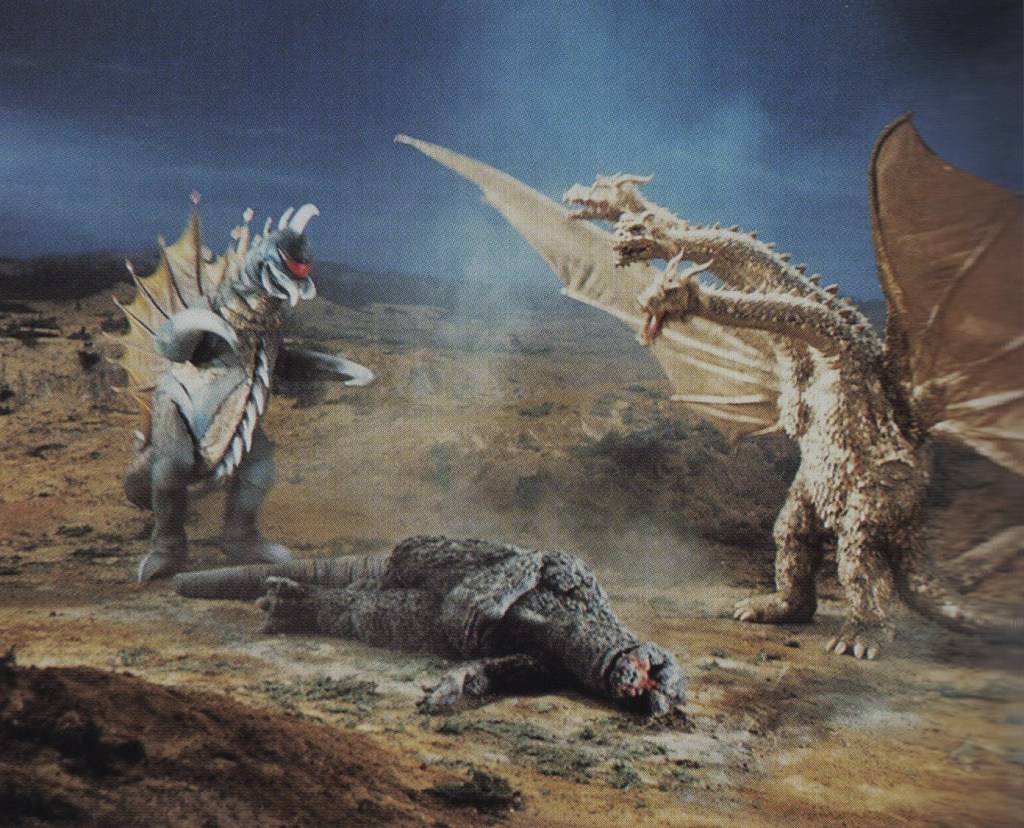

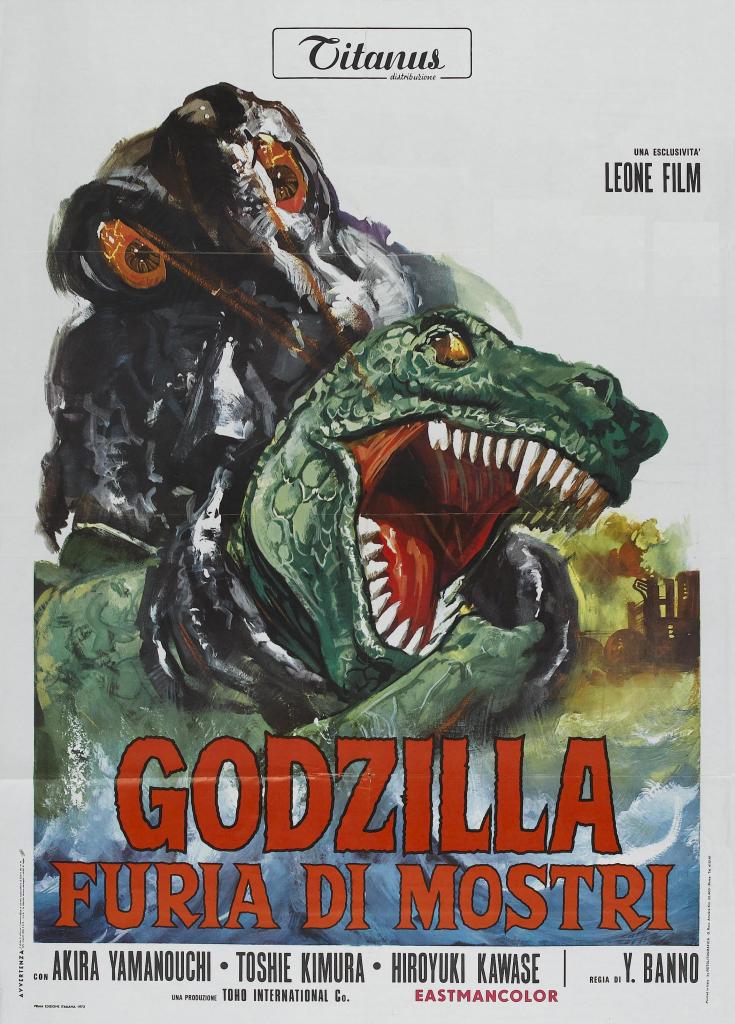

 n, he’s playing with Godzilla toys in his backyard. Throughout the film he claims to have dreams and premonitions of Godzilla rising up out of the sea to rescue mankind from Hedorah, who has evolved into a biped with the ability to fly, and has decimated Tokyo, leaving many dead. The film is presented in a strange, almost dreamlike manner, inter-cutting jazzy 70’s split-screen techniques, frightening hallucination/dream sequences, and even occasional short animated sequences, which really lends credibility to the idea that this film could actually just be Ken’s fantasy. Perhaps we never really leave the backyard and Ken’s clunky, plastic monster dolls are playing out the events of Godzilla VS Hedorah for us. While the movie certainly presents itself as being cannon, there is enough here to justify the “child’s fantasy” idea, and the movie is open ended enough, if you want it to be. Several important monster related plot points are triggered by Ken’s “visions”, and these sometimes carry an odd imaginative feel, such as when Ken claims to spot Godzilla lurking unseen by anyone else amongst the city’s skyline while riding a roller coaster.
n, he’s playing with Godzilla toys in his backyard. Throughout the film he claims to have dreams and premonitions of Godzilla rising up out of the sea to rescue mankind from Hedorah, who has evolved into a biped with the ability to fly, and has decimated Tokyo, leaving many dead. The film is presented in a strange, almost dreamlike manner, inter-cutting jazzy 70’s split-screen techniques, frightening hallucination/dream sequences, and even occasional short animated sequences, which really lends credibility to the idea that this film could actually just be Ken’s fantasy. Perhaps we never really leave the backyard and Ken’s clunky, plastic monster dolls are playing out the events of Godzilla VS Hedorah for us. While the movie certainly presents itself as being cannon, there is enough here to justify the “child’s fantasy” idea, and the movie is open ended enough, if you want it to be. Several important monster related plot points are triggered by Ken’s “visions”, and these sometimes carry an odd imaginative feel, such as when Ken claims to spot Godzilla lurking unseen by anyone else amongst the city’s skyline while riding a roller coaster.



 top secret research laboratory located on a remote island. Their experiments, focused on climate control, backfire, heating up the island to near unlivable temperatures, as well as causing a freak mutation in the island’s already pretty giant bugs, this time making them really, really giant. Things couldn’t get any worse, just kidding, of course they can- the giant bugs dig up an egg, which hatches. The hatchling? Apparently Godzilla JR! Eager to buck the absentee father kaiju dinosaur stereotype, Godzilla trods up onto shore for some good old fashioned monster child rearing. Things with our scientists are bad, they all got weird jungle fever, there is increased tension amongst the ranks, and now the island has turned into a full on Kaiju ass-whooping zone, so these are for sure stressful days. Their only hope for salvation comes in the form a mysterious woman found living on the island, and, of course, through Godzilla’s innate skill at clobbering the hell out of anything and everything.
top secret research laboratory located on a remote island. Their experiments, focused on climate control, backfire, heating up the island to near unlivable temperatures, as well as causing a freak mutation in the island’s already pretty giant bugs, this time making them really, really giant. Things couldn’t get any worse, just kidding, of course they can- the giant bugs dig up an egg, which hatches. The hatchling? Apparently Godzilla JR! Eager to buck the absentee father kaiju dinosaur stereotype, Godzilla trods up onto shore for some good old fashioned monster child rearing. Things with our scientists are bad, they all got weird jungle fever, there is increased tension amongst the ranks, and now the island has turned into a full on Kaiju ass-whooping zone, so these are for sure stressful days. Their only hope for salvation comes in the form a mysterious woman found living on the island, and, of course, through Godzilla’s innate skill at clobbering the hell out of anything and everything. less masterfully crafted than they have in the past, although there is passable use of insect puppetry here. It’s clearly meant to be more of a children’s film than past Godzilla flicks, but it’s not so over the top that adults needs be concerned, and little Godzilla Jr. (I should stop pretending that I don’t know his name- it just wasn’t ever mentioned in this film) doesn’t approach Jar Jar levels of annoyance by any means… At least, not in this movie, he doesn’t.
less masterfully crafted than they have in the past, although there is passable use of insect puppetry here. It’s clearly meant to be more of a children’s film than past Godzilla flicks, but it’s not so over the top that adults needs be concerned, and little Godzilla Jr. (I should stop pretending that I don’t know his name- it just wasn’t ever mentioned in this film) doesn’t approach Jar Jar levels of annoyance by any means… At least, not in this movie, he doesn’t.

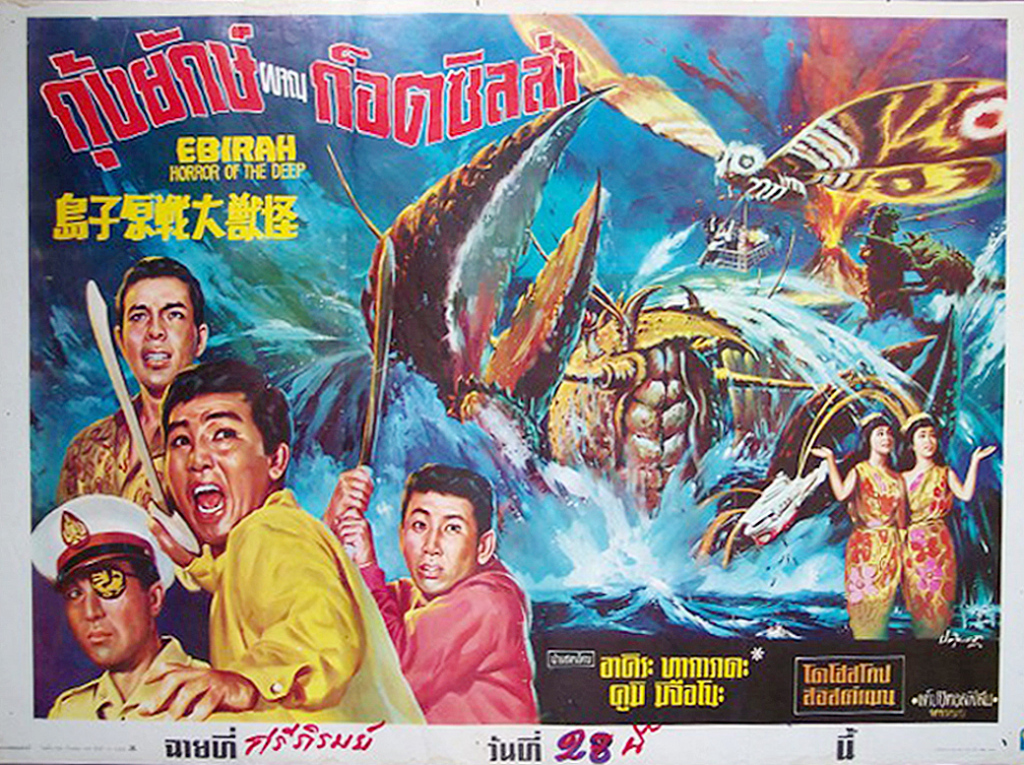
 I imagine that Ebirah would be Godzilla’s most delicious foe.
I imagine that Ebirah would be Godzilla’s most delicious foe.